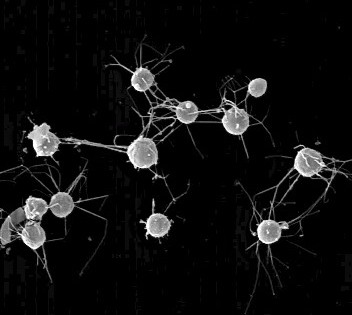The evolutionary history behind the origin of animals and fungi revealed
Science is full of SHEroes whose passion, work and creativity inspired Evolutionary Biologists of today.
As part of our commitment with society, the Institute of Evolutionary Biology (IBE, CSIC-UPF) wants to give credit and visibility to the achievements of female scientists in evolution.
To that aim, we launched the campaign #WhoisyourSHEro to share stories of women who had an impact in our researchers' scientific career through our social media and website.
The campaign keeps on moving as more and more women in evolution are inspiring the IBE community.
You can join the conversation through social media under the hashtag #WhoisyourSHEro.
With the collaboration of the Spanish Foundation for Science and Technology - Ministry of Science and Innovation.
 |
The evolutionary history behind the origin of animals and fungi revealed
An international research team led by the Institute of Evolutionary Biology (IBE) has reconstructed for the first time the process of genetic changes that culminated with the appearance of animals and fungi from a common ancestor.
Published in the prestigious journal Nature, the study has analysed for the first time the genome of four unicellular relatives of animals and fungi to reveal the evolutionary history behind the origin of both groups using advanced computational techniques and big data.
The results point out that animals and fungi evolved through two highly divergent pathways of genetic change, and that these distinct routes gradually set the stage for their emergence.

Animals and fungi have radically different morphologies, ecological traits and behaviours, yet both evolved within the same eukaryotic supergroup, Opisthokonta. Although they share a not-so-distant ancestor, the lack of genomic data on the opisthokonth groups that branch between animals and fungi has made it difficult to understand the process of divergence that culminated in the appearance of both groups.
A research team led by the Institute of Evolutionary Biology (IBE), a joint research centre of the Spanish National Research Council (CSIC) and Pompeu Fabra University (UPF), has reconstructed the trajectory of the key genetic changes that explain how opisthokonths diverged to originate animals and fungi from a common ancestor.
The results indicate that animals and fungi evolved through two very contrasting trajectories of genetic changes, and that these differences were prior to the origin of both groups. "The gradual establishment of two clearly differentiated genomic contexts set the stage for the appearance of animals and fungi", explains Iñaki Ruiz-Trillo, ICREA principal investigator of the IBE Multicellgenome Lab and head of the study.
"The gradual establishment of two clearly differentiated genomic contexts set the stage for the appearance of animals and fungi", explains Iñaki Ruiz-Trillo, ICREA principal investigator of the IBE and head of the study.
 Using an updated dataset, which includes four new genomes from crucial positions in the Opisthokonta phylogeny, the international team shows that animals arose only after a long accumulation of functionally important genes for multicellularity in their ancestors. "Instead, the pre-fungal ancestors entered a path of multicellularity-related gene loss, and of greater representation of metabolic genes, more similar to that presented by the closest unicellular relatives to animals and fungi - protists”, adds Eduard Ocaña-Pallarès, previously a predoctoral student in Ruiz-Trillo's group at the IBE and first author of the study.
Using an updated dataset, which includes four new genomes from crucial positions in the Opisthokonta phylogeny, the international team shows that animals arose only after a long accumulation of functionally important genes for multicellularity in their ancestors. "Instead, the pre-fungal ancestors entered a path of multicellularity-related gene loss, and of greater representation of metabolic genes, more similar to that presented by the closest unicellular relatives to animals and fungi - protists”, adds Eduard Ocaña-Pallarès, previously a predoctoral student in Ruiz-Trillo's group at the IBE and first author of the study.
The study indicates that the origin of animals was not a one-off event, but part of a much longer and complex evolutionary process.
The study indicates that the origin of animals was not a one-off event, but part of a much longer and complex evolutionary process. "One might think that the origin of animals was a drastic evolutionary event, but our analysis shows that its likelihood gradually increased at the genomic level, underscoring the importance of looking at evolutionary transitions over longer time frames than may seem obvious", concludes Ruiz-Trillo.
The results imply that to understand unique and extraordinary events in the history of biological diversity, such as the origin of animals and fungi, it is essential to unravel and understand their previous evolutionary history.
Reference article: Ocaña-Pallarès, E., et.al. 'Divergent genomic trajectories predate the origin of animals and fungi'; Nature, August 2022. DOI: https://www.nature.com/articles/s41586-022-05110-4 ; https://doi.org/10.1038/s41586-022-05110-4
